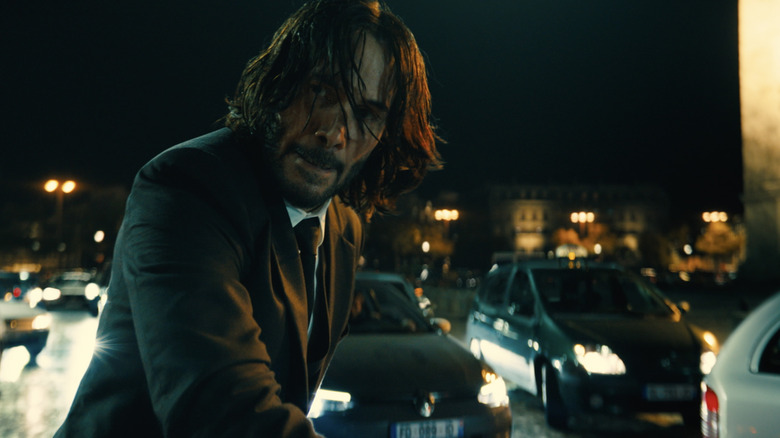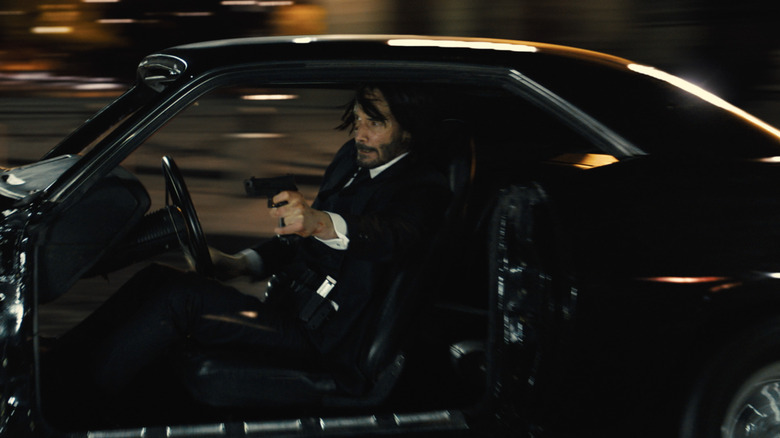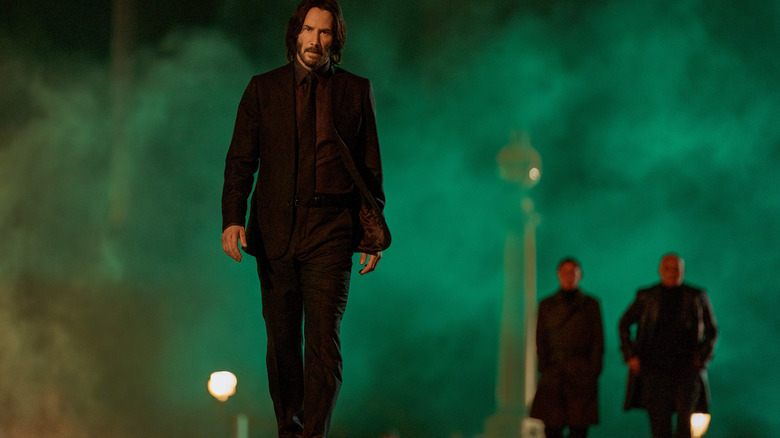John Wick 4 Stunt Coordinators Explain How To Get Hit By A Car ... Safely [Exclusive]
This post contains spoilers for "John Wick: Chapter 4."
In the rather extended, multi-armed climax of Chad Stahelski's latest entry in the greatest modern action franchise, "John Wick: Chapter 4," the title character (Keanu Reeves) finds himself dodging a literal army of assassins in the streets of Paris. John Wick is on his way to a climactic duel, but has to spend nearly 40 straight minutes of the film (not an exaggeration) getting past hundreds of murderous thugs before he can get there. A portion of his fight takes Mr. Wick to the traffic circle around the Arc de Triomphe, where he takes control of first a car, then a motorcycle, firing bullets into every adversary that wanders into his field of vision. During this deadly kerfuffle, John Wick is hit by numerous cars, bounces off of windshields, flips onto hoods, and generally suffers all manner of vehicular trauma. Because he is John Wick, however, and because only Keanu Reeves can do what Keanu Reeves does, the injuries merely hurt, allowing our hero to escape any serious damage.
The stunt team on "John Wick: Chapter 4" are the real stars of the movie. Hundreds of stunt performers not only have to get into fights, but tumble down stairs, crash through glass, fall off of precipices, and mime getting stabbed to death. Reeves did some of his own fighting, but it was one of Reeves' stunt doubles that rolled down 222 stairs and jumped into the front of a moving car.
The film's lead stunt coordinators, Scott Rogers and Stephen Dunlevy, recently talked with /Film about their hard work, and Rogers laid out how the Arc de Triomphe sequence was visualized, what kind of training went into making it, and how it was filmed. For those who haven't yet seen the sequence, imagine a high-octane game of "Frogger," but where all the cars are also shooting at you.
The ultimate secret: padding
While one might assume a lot of the stunts in "Chapter 4" were aided by CGI, the times stunt people got hit by cars were 100% real, and choreographed like fight scenes. And, because the "John Wick" movies are so high-profile in the stunt community, everyone was lining up to work on it. The secret to keeping the stunt performers safe, Rogers revealed, was padding. A lot of padding. And even then, someone could still get hurt. Roger said:
"I guess that was one of the hardest things, is making sure things are safe. It's 'John Wick,' and stunt people all want to be on the movie, everybody wants to work on it, wants to do this. But it is dangerous. Ultimately, you're getting hit by a car. We do have the luxury of VFX so we can make padded cars; we can put padding on cars, we can put padding on the ground, and that can protect your brain, but you can still ding your shoulder. And we sprained an ankle, and one guy hurt his shoulder a little bit, but that was it."
A sprained ankle and a hurt shoulder hardly seem terrible, given the dangerous nature of the job. It seems that the padding was key, and Roger said, "It's a challenge, but we mitigate those dangers by using padding wherever we can." If there was any CGI used in "John Wick: Chapter 4," it was likely used to erase any visible padding. Stunt performers also tend to wear padded suits anyway, allowing them to bounce around fast-moving vehicles without any kind of serious injury.
For the love of God, hit your mark
Rogers also noted that having incredibly skilled drivers was vital. It's one thing when an actor needs to hit their mark to follow the blocking of a scene correctly. It's quite another when a stunt driver needs to hit their mark, as going too far or falling too short could result in grievous bodily harm. When the car stops where it needs to, and the stunt performer jumps at the precise moment, the two can make it look like someone was hit by a car, when really the padding and the timing are keeping them safe. It seems that, apart from the aforementioned ankle and shoulder, everyone left the set safe and unharmed. Rogers said:
"[T]he drivers of the cars are some of the world's best and they're sliding to a mark. So you as a fighter, getting to this mark and this car's coming to this mark so it looks worse than it is, as long as everybody hits their mark. And I'm very proud of the fact that how we did it and what we did and the fact that most everybody walked away unscathed. And like I said, I think we sprained an ankle and we dinged a shoulder. Besides that, everybody walked away and we did some really big hits."
The final hour of "John Wick: Chapter 4" is an epic of stunt performance, with the car sequence being followed by a shooting sequence inside a dilapidated building, and then a fight scene up a very long outdoor staircase. Hundreds of people were involved. The action is exhausting, but the stunts are as slick and amazing as this series has always provided.


